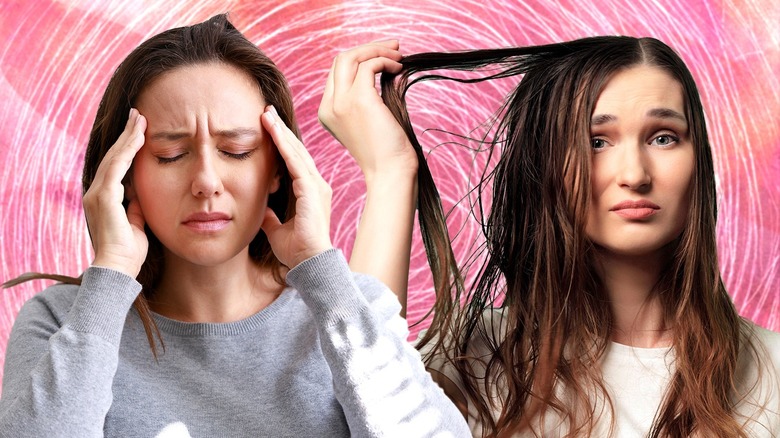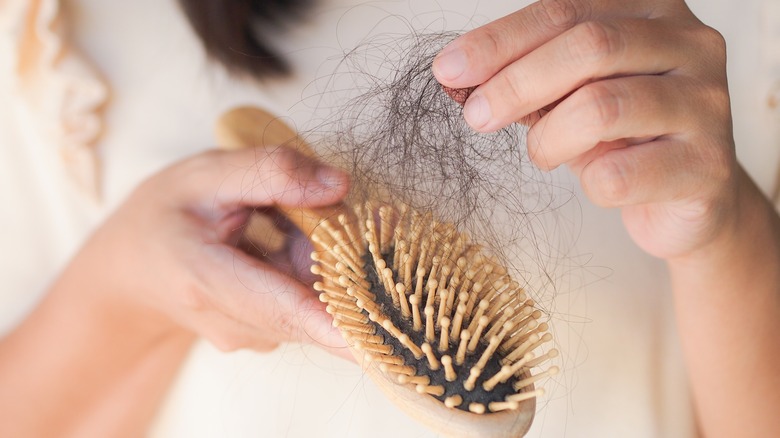Scalp Popping: Why You Shouldn't Try This Viral Headache Relief Method
When you have a headache, you'll do just about anything to ease the pain and tension. However, it's important to proceed with caution, as many so-called remedies can actually make things worse and create new problems down the road. For example, scalp popping, the practice of popping your scalp by twisting and pulling a small section of hair, is thought to relieve migraines and headaches. However, whether or not it's effective (or safe) is another matter altogether.
Chucaque, a head massage technique used in the Peruvian Andes, looks pretty much identical to the scalp popping trend described above. Dr. Julio Cachay, an internist at Clínica Ricardo Palma, claims that chucaque can provide immediate pain relief and doesn't pose any dangers. In his opinion, this technique helps relax the muscles, which in turn may ease tension headaches. However, other experts say it's anything but safe.
Also known as hair cracking, this practice has gained popularity in recent months thanks to social media. For example, a TikTik video showing a man having his hair pulled by a barber got over 1.7 million views, 12,500 comments, and 28,000 shares. The popping sound coming from the guy's head is loud enough to send a chill down your spine. However, there are a few reasons you might want to avoid trying this yourself.
What on earth is scalp popping?
While there are plenty of natural ways to get rid of headaches, only a few actually work. For example, ginger tea and peppermint oil are pretty safe and can temporarily reduce pain. Unfortunately, the same can't be said about scalp popping, the viral TikTok trend that's causing people to pull their hair in an attempt to relieve headaches. This technique involves twisting a small section of your hair and then pulling it hard enough to make your scalp pop. After you hear a popping sound, grab another section of hair and repeat.
"The 'popping' sound you hear is the galea aponeurotica (soft tissue between your scalp and skull) popping off your skull," hair transplant specialist Gokhan Vayni told Tyla. Aesthetic doctor Ross Perry, one of the experts interviewed by Tyla, warns that hair cracking can result in scalp bleeding, sores, infections, and hair loss. "Let's not forget [the] damage to the neck and head from the force of the hair being pulled," he added. This practice is deemed unsafe and lacks scientific proof, but it still has plenty of fans.
One Reddit user describes scalp popping as being "more startling than relaxing." However, others claim it can relieve headaches in as little as two minutes by decreasing the tension built up in this area. Some even compare it to a scalp massage, saying it feels great.
Scalp popping can cause more harm than good
There are currently no studies related to the benefits and risks of scalp popping. However, this practice may pose similar risks as trichotillomania, a mental health disorder associated with compulsive hair pulling. People with trichotillomania may experience bruising, scarring, redness, scalp infections, and permanent hair loss, among other complications.
Neurologist Jan Brandes told Healthline that scalp popping causes discomfort, which may distract people from their pain and give them a false sense of relief. But even so, its risks outweigh any potential benefits. "I think it's a really bad idea. You could pull out [your] hair. You might create folliculitis or even tear your scalp," warns Dr. Brandes. Other complications may include scalp inflammation, wounds, and hair damage.
All in all, there are safer ways to get relief from headaches and migraines. For example, you could try a cooling headache hat to ease the pain. Evidence also suggests that omega-3s may help with migraines, so make sure your diet includes fatty fish, nuts, seeds, and avocados, and some hairstyles can help keep migraines at bay, too. Still, if your symptoms persist, see a doctor sooner rather than later. Sometimes, chronic headaches can indicate a more serious condition, such as meningitis, stroke, or increased intracranial pressure.

